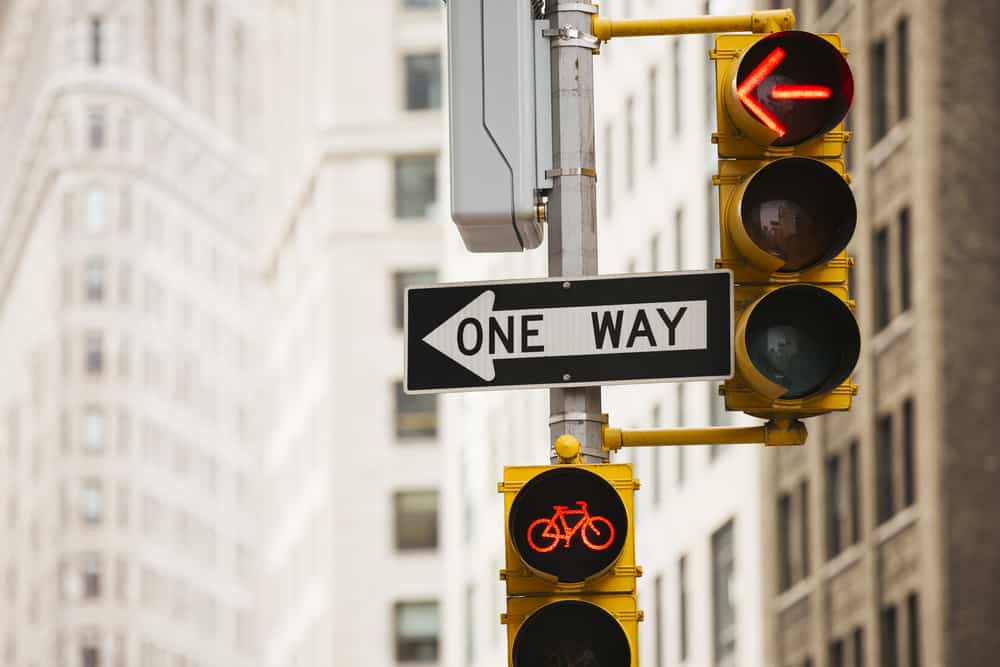Can You Ride A Bike Down A One Way Street?

Depending on where you live, bicycles can be a great way to get around town. Riding a bike in the ever-busy streets of major cities is an essential mode of transportation for many residents. Unfortunately, there seem to be too many cyclists out there who just assume that they know the rules but never actually bother to look them up. Once they look them up, they may be surprised by what they find.
It is legal to ride a bike down a one-way street; however, specific rules vary between states and municipalities. Yet, it is illegal to ride a bike down a one-way road the wrong way. Bicycles must also use a bike lane if one is present and are sometimes prohibited from riding on the sidewalk.
Cycling in a major city can be both a thrilling and terrifying experience. To avoid experiencing the latter, cyclists can familiarize themselves with local traffic laws. The traffic rules that apply to cyclists can sometimes be ambiguous, such as whether a cyclist can ride a bike down a one-way street.
Is It Illegal To Ride A Bike Down A One Way Street?
First and foremost, in a country like the U.S., which is governed by federal, state, and municipal laws, traffic laws can vary from state to state and from city to city. So, if you are planning on cycling around a city you are unfamiliar with, consider double-checking its laws for bikers, as there could be some specifics you should be aware of for your own sake.
In New York City (NYC) and other metropolitans where many people find it essential to use a bike to get around, cyclists have the same rights and must follow the same rules as motor vehicles. Cyclists must obey traffic lights, signals, and road signs. Thus, bicyclists do have the right to go down a way one street, so long as it is in the right direction.
For the most part, NYC does make an effort to accommodate cyclists. The city is covered with bike lanes where there is enough room for them. If you find a bike lane going down a one-way street, it is in your best interest and obligation to use it instead of the road used by other motorized vehicles.
However, the truth about NYC and other major cities is that you’ll find plenty of one-way streets free of bike lanes. In such cases, you can still cycle on the street since bicycle riding is allowed on the city streets throughout the city, even when no designated bike lane exists. The cyclist must ride on the right end of the road close to the pavement or curb.
Can You Ride A Bike Down A One Way Street Elsewhere In The U.S.?
As previously mentioned, traffic laws can vary slightly depending on where you cycle in the U.S. For instance, a cyclist may also ride down a one-way road in California, but the one-way must contain two or more lanes.
However, in the state of New York, specifically in the cramped streets of NYC, a cyclist is bound to come across a one-way street that features only a single lane. If you applied the California road rules to NYC, the cyclist would technically not be allowed to ride down the one-way, but according to the NYC rules, they can.
Can You Ride A Bike The Wrong Way Down A One Way Street?
You’ll find a surprising amount of forum entries on the web in which people claim it is legal for cyclists to ride their bikes in the wrong direction down a one-way street. Some justify these opinions by stating that cyclists only need to give way to vehicles that are going the right way.
However, though many cyclists can and do ride the wrong way down one-way streets, it is unquestionably against the. Since the same rules that apply to cars also apply to cyclists, just as motor vehicles are not permitted to drive the wrong way on a one-way road, so are the cyclists.
In the busy streets of cities like NYC, cyclists can save a significant amount of time on their trip by going the wrong way up a one-way road, but the truth is that they are violating the law and disregarding the safety of others when doing so.

Can You Ride A Bike On The Side Walk?
One of the most common violations for bikers in NYC is getting caught riding their bike on the sidewalk. It is no wonder that riding a bike on the sidewalk is prohibited in major cities, as bicyclists riding on sidewalks can become a major hazard for pedestrians by causing collisions or other forms of conflict.
Getting caught by law enforcement while riding a bike down on the sidewalk can result in:
- A confiscated bike
- A fine up to a hundred dollars
- Further legal sanctions
There are some exceptions to this rule, however. Riders who are aged 12 and younger and whose bicycle wheels have a diameter that is less than 26 inches can ride on the sidewalk. Nonetheless, walking with your bike on the sidewalk is always allowed.
In California’s case no state-wide law prevents bicyclists from riding on the sidewalk. It is, therefore, up to the local municipalities to determine their own rules. So, this traffic law can vary between cities and counties. Cyclists should be aware of and follow the rules in their own respective areas.
Unlike in NYC, In Los Angeles, California, cyclists are allowed on the sidewalk as long as they don’t exhibit what could be interpreted as deliberate disregard for the safety of people or property.
Is It Illegal To Cycle Two Abreast?
Cyclists are usually allowed to ride two abreast but no more, even when there is enough space for more, but do make sure to double-check this rule in your specific area.
In California and New York alike, the rules stipulate that there may be no more than two cyclists riding side by side on a bike lane or roadway. If other vehicles are attempting to overtake, the cyclists must switch to a single file formation to let the vehicle pass. The same rule applies when cyclists are overtaking a vehicle, bicycles, or pedestrians themselves.
It is worth noting that cycling two abreast leaves more opportunity for a rider to hit an opened car door since there is less room than recommended between the rider and a parked car, especially in a city with much traffic. A rider should always try to maintain a 3 feet gap between themselves and parked cars.
Conclusion
Bicyclists are generally allowed to ride down way streets, but specific laws may vary between individual states and municipalities. However, you may not ride a bike down a one-way road in the opposite direction unless a specific bike line allows you to.
Some cities and states allow for bicycles to be ridden on sidewalks, while other places prohibit them safe for a few exceptions.







